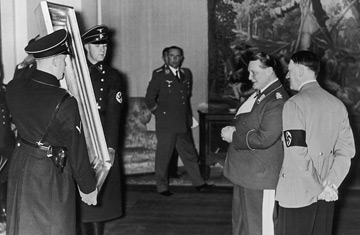
Art Lovers: German Field-Marshal Hermann Goering admires a painting given to him by Adolf Hitler for his 45th birthday
Gerrit Dou's Astronomer by Candlelight is familiar to any fan of 17th-century Dutch masters. But if a recent claim by heirs to one of the most prominent World War II-era Dutch art dealers succeeds, Dou's painting will be taken from Leiden's De Lakenhal Museum and returned to the family of Nathan Katz. In all, Katz' four children are claiming 225 paintings and two tapestries from museums and institutions throughout the Netherlands.
"These are quite important collector paintings," says De Lakenhal's chief curator Christiaan Vogelaar of the seven disputed works at his museum. Although his museum has returned art stolen or purchased by the Nazis before, Vogelaar says the Katz claim came as a surprise. "People thought it was over because of the settlement after the war," says Vogelaar, referring to the 28 paintings returned to the Katz family in the 1940s. They include Rembrandt's Portrait of a Man, which is thought to have been bartered by Nathan in exchange for visas for his extended family and his mother's release from the Dutch concentration camp, Westerbork.
The family's claim is the largest ever made to the Dutch government. After the war, it reclaimed many works of art stolen or bought by the Nazis during the occupation of the Netherlands. Destitute and trying to build up its coffers, the government discouraged claims, wanting returning Jewish families to buy back their art instead. It was an impossible feat for many. Claims were dismissed as thousands of works of art held by the state were loaned to Dutch institutions, many prominently on display for decades in national museums as their families tried to get them back.
Under pressure, the government set up the Restitution Committee in 2001 to advise it on the return of cultural assets seized or involuntarily sold during the Occupation. As of this summer, 89 restitution claims had been made, 45 of which have been reported on by the Committee. The government has so far followed the Committee's advice in all cases, some 75 percent favorably resolved for the claimants. "They've made a big effort to make right what was done wrong," says Joel Cahen, Director of the Jewish Historical Museum in Amsterdam. Ministry of Culture spokesman Bob van het Klooster says people can submit claims indefinitely, although they expect the Katz' are the last of the big claims. "There aren't any more big art dealers left who had to flee."
It will take at least a year for the Committee to go through the Katz claim. By all accounts, the Katz case is more complex than most restitution claims. Nathan and his brother Benjamin were not just private owners, but dealers with a thriving art gallery in their hometown of Dieren in the east of the country. They continued to buy and sell art throughout the war, even if from Basel, Switzerland, where Nathan moved his family in 1942. Many of their dealings were with Nazi art procurer Alois Miedl, who bought art for Hermann Goering and others. "Everyone says Nathan Katz's sales were voluntary, that he collaborated," says Cees van Hoore, a reporter for the Haarlems Dagblad who broke the story of the Katz claim last week. "But no one can explain why Nathan fled to Switzerland. What would have happened if he hadn't sold them?"
In the end, the Katz claim will hinge on whether they sold voluntarily or not. The family says it's clear: Any sale between German intermediaries and Jews during the war years was forced. But according to the rules of the Restitution Committee, only sales by individuals under duress made after the Nazis occupied the Netherlands in May 1940 are unquestionably considered involuntary. For dealers, the bar is higher, all the more so because they themselves often bought from other Jewish people desperate to flee. It is the original owners who are entitled to the disputed works, which is up to the Committee to determine.
For the museums that stand to lose some of their most prized works, it's all a tad bittersweet. The Frans Hal Museum in Haarlem has eight Golden Century paintings from the Katz collection on long-term loan from the national collection. They are works of "enormous importance," says Louis Pirenne, the museum's head of public affairs. "Paintings like these are important to the mid-scale museums in the Netherlands. We buy around these centerpieces in our collection." Although the loss would be huge, Pirenne says his museum respects the judgments of the Restitution Committee. "We've always realized we don't own them." But determining who does is proving a lot harder.
